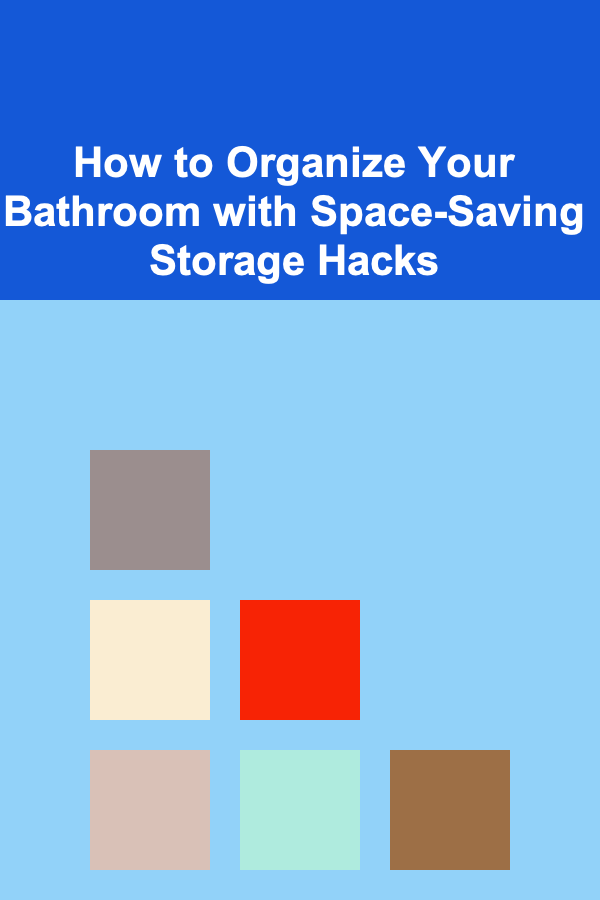
How to Clean Your Home After a DIY Home Renovation
ebook include PDF & Audio bundle (Micro Guide)
$12.99$7.99
Limited Time Offer! Order within the next:

DIY home renovation projects can be both exciting and rewarding, but they also leave behind a significant amount of mess. Whether you've tackled painting, flooring, tiling, or other home improvement tasks, cleaning up after a renovation is no small feat. The dust, debris, and residual materials can be overwhelming, but with a systematic approach, you can restore your home to its pre-renovation state---and often, make it even cleaner than before the work started.
Cleaning up after a DIY renovation requires time, patience, and attention to detail. It's not just about picking up stray nails or sweeping up dust; it's about tackling the entire space and ensuring that every surface is cleaned properly, removing contaminants, and restoring your home's comfort and aesthetic.
In this article, we'll dive deep into the steps and strategies you should follow when cleaning your home after a DIY renovation. We'll cover preparation, cleaning tools, strategies for various types of renovation debris, and how to maintain a clean home after the renovation work is completed.
Preparation: Gathering Supplies and Tools
Before you dive into cleaning, you'll need to gather the right cleaning supplies and tools. Depending on the extent of the renovation and the materials used, your cleaning approach might vary slightly. However, there are some core supplies you'll need to have on hand.
Cleaning Supplies Checklist
- Vacuum Cleaner: A vacuum with a HEPA filter is ideal for picking up fine dust and debris.
- Microfiber Cloths: These are great for dusting and cleaning all surfaces without leaving streaks.
- Sponges and Scrub Brushes: You'll need these for scrubbing tough spots on walls, floors, and counters.
- Bucket and Mop: For cleaning the floors and mopping up spills.
- All-Purpose Cleaner: A good all-purpose cleaner can handle most surfaces and stains.
- Heavy-Duty Cleaner or Degreaser: These are needed if you've worked with materials like grease or oil.
- Rags or Paper Towels: Useful for wiping down surfaces and cleaning up spills.
- Protective Gear: Wear safety glasses, gloves, and a dust mask to protect yourself from dust and debris.
- Trash Bags or Containers: You'll need several trash bags to dispose of renovation debris and materials.
- Cleaning Solution for Windows and Glass: To remove smudges and dust from glass surfaces.
- Dusting Tools: Dusting brushes, dustpans, and brooms for cleaning up fine dust particles.
Additional Tools
- Shop Vacuum: If you have a lot of large debris (such as wood scraps or tile pieces), a shop vacuum can be more efficient than a regular vacuum cleaner.
- Steam Cleaner: This is ideal for cleaning and sanitizing floors, especially if you've done a lot of tiling or other surface work.
- Floor Scraper: If you've replaced flooring, you may need a scraper to remove glue, paint, or other residue.
- Ladder or Step Stool: For reaching high places, like ceilings and walls, to ensure every surface gets cleaned.
Tidy Up the Work Area
Clearing Away Large Debris
Once you've gathered your cleaning supplies, the first step is to clear away any large debris left from the renovation. This includes leftover materials like:
- Wood scraps
- Tile shards
- Broken pieces of drywall
- Old flooring
- Packaging from new materials
- Paint cans or buckets
- Leftover hardware (nails, screws, etc.)
Start by picking up anything that can be easily disposed of. Place these items in trash bags or bins, and ensure you dispose of hazardous materials---such as broken glass, sharp nails, or paint cans---properly according to your local regulations.
Move Furniture and Cover Sensitive Areas
Next, remove any furniture or belongings that might be in the way. If there are large items that can't be moved, cover them with protective tarps or plastic sheeting to shield them from dust. It's important to also consider covering air vents, light fixtures, and other sensitive areas that might attract dust.
If you've renovated an area like the kitchen or bathroom, make sure appliances, sinks, and countertops are covered to avoid getting grime or chemicals on them during the cleaning process.
Dusting and Vacuuming
After you've removed large debris and covered sensitive areas, the real cleaning can begin. One of the most important steps is dealing with the dust, which can accumulate in almost every nook and cranny after a renovation. Dusting should be done before any wet cleaning, as wet mopping or wiping down dusty surfaces can lead to streaks and grime buildup.
Start High, Finish Low
When cleaning dust, always start at the top and work your way down. This means tackling ceilings, walls, and light fixtures first, followed by furniture, and then finishing with the floors. By following this order, you'll avoid redistributing dust onto surfaces you've already cleaned.
- Ceiling: Dust and cobwebs can accumulate on ceilings, especially if work has been done in that area. Use a dust mop, broom, or extendable duster to clear away any dust or cobwebs.
- Walls: Use a microfiber cloth or a soft broom to gently remove dust from the walls. For stubborn spots, dampen a cloth with warm water and mild soap.
- Baseboards and Trim: These areas are prone to dust accumulation, so be sure to give them extra attention. Use a microfiber cloth or a soft duster.
- Furniture and Fixtures: Dust any furniture, shelves, or decorative items that might have been left in the room. Clean light fixtures and ceiling fans, as they can accumulate dust over time.
- Windows and Doors: Clean window sills and tracks, which can collect dirt and dust from the construction process. A vacuum or compressed air can help remove dirt from window tracks.
Vacuuming Floors
Once all the high-up surfaces are cleaned, you can begin vacuuming the floors. Use a vacuum with a HEPA filter to ensure it captures fine dust particles. Start by vacuuming in corners and along the edges of the room, and then move across the larger surfaces. Pay attention to any carpeted areas, as they can trap dust and debris. For hard floors, use a vacuum with a hard floor setting to avoid scratching.
Dealing with Stubborn Cleaning Tasks
Cleaning Floors
After vacuuming, it's time to focus on the floors. The type of floor you have will determine the best cleaning method.
- Hardwood Floors: Clean wood floors with a gentle cleaner designed specifically for hardwood. Avoid using too much water, as it can damage the wood. Mop with a damp cloth rather than a soaked mop.
- Tile Floors: Tile floors may need extra attention to remove grout, dust, and adhesive residue. A pH-neutral cleaner or tile cleaner is ideal for this type of flooring.
- Carpets: If you've replaced flooring or just need to freshen up your existing carpet, consider deep cleaning with a steam cleaner. It will remove dust, dirt, and stains while sanitizing the fibers.
Cleaning Walls and Cabinets
After cleaning floors, focus on your walls and cabinets, which may have accumulated dust, paint splatters, or sticky residues. Use a damp cloth with mild soap or an all-purpose cleaner to wipe down these surfaces. If you've done any painting, you might need a specialized cleaner to remove excess paint or adhesive.
Final Touches
After cleaning the larger areas, make sure to take the time to:
- Clean Vents: Renovation work can stir up a lot of dust, and vents are a prime spot for it to settle. Vacuum or wipe down air vents, and consider replacing air filters if they've been clogged with dust.
- Check for Remaining Dust: Once you've finished cleaning, inspect the room from various angles for any leftover dust or grime. This is particularly important for surfaces like countertops and table surfaces that are used frequently.
- Odor Removal: Finally, if there's a lingering renovation smell (such as paint fumes or dust), use air purifiers, open windows, and use odor-neutralizing sprays. A bowl of vinegar or baking soda can help absorb odors.
How to Maintain a Clean Home After Renovation
Cleaning after a DIY home renovation is one task, but maintaining that cleanliness is another. To keep your home tidy and fresh:
- Regularly dust surfaces and vacuum.
- Clean up small messes or spills as soon as they happen.
- Consider setting up a cleaning schedule to avoid letting dust accumulate again.
- Make sure that any future renovation projects are organized with proper cleanup protocols in place.
Conclusion
Cleaning your home after a DIY renovation project can feel daunting, but with the right approach, it becomes a manageable task. By following a methodical process that involves preparation, dusting, vacuuming, and detailed cleaning, you can restore your home to its pre-renovation state---or even make it cleaner than before.
Remember, patience is key. DIY renovations are a lot of work, and cleaning them up takes time and attention. With the proper tools and a step-by-step plan, you can enjoy your newly renovated space and ensure that it remains clean and fresh for years to come.
Reading More From Our Other Websites
- [Personal Care Tips 101] How to Train for a Marathon as a Beginner
- [Skydiving Tip 101] Top & Safety Tips Every Tandem Skydiver Should Know
- [Star Gazing Tip 101] Night Sky Adventures: Simple Star‑Gazing Projects for Kids
- [Home Renovating 101] How to Renovate Your Home with DIY Projects
- [Personal Care Tips 101] How to Choose Body Spray for a Relaxing Evening or Night Out
- [Star Gazing Tip 101] Beyond the Stars: The Science of How Constellations Are Formed and Categorized
- [Organization Tip 101] How to Keep Your Outdoor Furniture Organized and Protected
- [Personal Finance Management 101] How to Build an Emergency Fund Without Feeling Overwhelmed
- [Personal Care Tips 101] How to Choose the Best Razor for Sensitive Skin
- [Organization Tip 101] How to Create a Backup Plan for Emergency Pet Supplies

How to Build DIY Shelving Units for Extra Storage in Your Home
Read More
How to Choose the Right Lighting for Your Living Room
Read More
How to Create a Neighborhood Watch Program for Better Security
Read More
How to Organize Your Bathroom with Space-Saving Storage Hacks
Read More
How to Save Money on Home Heating and Cooling with Smart Budgeting
Read More
How To Make Your Own Bread and Baked Goods
Read MoreOther Products

How to Build DIY Shelving Units for Extra Storage in Your Home
Read More
How to Choose the Right Lighting for Your Living Room
Read More
How to Create a Neighborhood Watch Program for Better Security
Read More
How to Organize Your Bathroom with Space-Saving Storage Hacks
Read More
How to Save Money on Home Heating and Cooling with Smart Budgeting
Read More